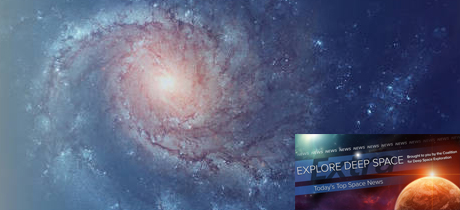In Today’s Deep Space Extra… Human deep space exploration coming to a new generation.
Human Deep Space Exploration
Ex-NASA official at CU’s Conference on World Affairs: ‘We have to keep exploring’
Daily Camera of Boulder, CO (4/10): Former NASA Deputy Administrator Dava Newman launched the University of Colorado at Boulder’s Conference on World Affairs with a speech. Many in the audience were young, and Newman explained how they will carry out the human deep space missions now being planned. “All of this exploring is not for the faint of heart,” explained Newman. “But we have to keep exploring.”
Wild interstellar flight system is among 22 futuristic ideas NASA just funded
Space.com (4/10): NASA investments in 22 new technologies are intended to advance the human exploration of the solar system and beyond. Among them are advanced propulsion systems, a linear artificial gravity concept and soil additives to grow crops on the Martian surface.
Mars human settlement discussed at Purdue conference
Purdue University Exponent (4/10): Guest speaker Robert Zubrin, founder of the Mars Society, calls for a human settlement on the red planet to determine if there was or is life there and to demonstrate that humanity can peacefully seek out new resources.
Space Science
NASA could use a miniaturized satellite to test Europa moon’s dust and radiation
Seeker (4/10): A specially instrumented CubeSat could enhance NASA’s planned Europa Clipper, an orbital mission to Jupiter that would carry out multiple fly-bys of the moon Europa. The small satellite, included as a secondary payload, would be equipped to assess the dust and radiation environments, factors in the ultimate determination of whether the ice and ocean covered moon is a habitable environment.
Science on the Hill: If these (Martian) rocks could talk
Santa Fe New Mexican (4/9): Seated aboard NASA’s Curiosity rover on Mars is ChemCam, an instrument with laser-like qualities that can zap and study rocks at Curiosity’s Gale Crater landing site for mineralogy that formed in the past in the presence of neutral water. SuperCam, an advanced version, will launch on NASA’s successor to Curiosity, the 2020 Mars rover. Thanks to an on-going collaboration between the Las Alamos National Laboratory and the French space agency, SuperCam will look for evidence of organics, the building blocks of life, as the 2020 rover explores the Martian surface in the next decade.
Space Coast scientist wants to study sun closer
Orlando Sentinel (4/10): A NASA grant could lead to a high temperature spacecraft coating that would permit a closer study of the sun. “We want to understand this great ball of energy,” says Robert Youngquist, a NASA physicist based in Melbourne, Florida. “You can only make certain measurements by getting close.”
Astronomers detect faintest ever early-universe galaxy
Cosmos (4/11): A faint smudge noted by astronomers in a deep space image from the Hubble Space Telescope turns out to be a major find, a small galaxy that formed 700 million years after the big bang and while the universe was in transition from dark to light.
Low Earth Orbit
Soyuz MS-02 trio returns to Earth
Spaceflight Insider (4/10): NASA’s Shane Kimbrough descended safely to Earth along with Russian cosmonauts Sergey Ryzhikov and Andrey Borisenko in Central Kazakhstan early Monday. The three men returned to Earth in their Soyuz MS-02 spacecraft following a 173-day mission to the International Space Station. U.S. and Russian replacements are to launch April 20.
Aerojet Rocketdyne bringing 800 rocket jobs to Alabama
Alabama.com (4/10): As part of a corporate consolidation, California-based Aerojet Rocketdyne plans to build a new rocket engine manufacturing plant in Huntsville, Alabama, a move that will bring an estimated 800 new jobs. “We believe these actions are essential for the performance of our business and the growth of the company,” Company President Eileen Drake said. “The results from this initiative will benefit our valued employees, customers and shareholders alike.” Aerojet is the manufacturer of the new AR1 rocket engine, a domestic replacement for imports of Russia’s RD-180.
X-37B: The Air Force’s mysterious space plane
Space.com (4/10): Inaugurated as a NASA project in 1999, the U.S. Air Force X-37B represents an ongoing investment in reusable orbital space technologies and a platform for testing new technologies and sensors that can be returned to Earth for assessment.
The small launch industry is about to be Amazoned
The Space Review (4/10): Jeff Bezos, founder of Blue Origin, discusses an upper stage modification to the suborbital New Shepard launch vehicle that could turn it into a rocket for the emerging small satellite market. Bezos, also the founder of Amazon.com, discussed the prospect at last week’s 33rd Space Symposium in Colorado Springs.

